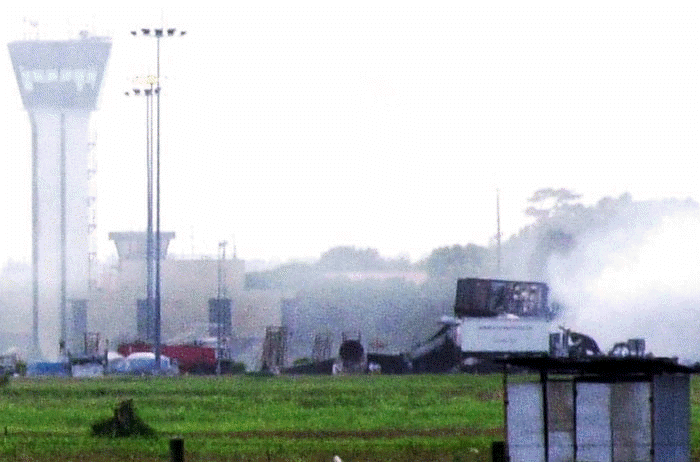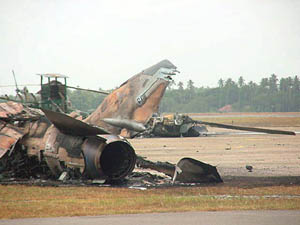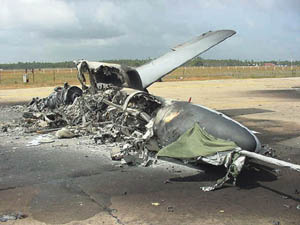Today marks 23 years since a team of 14 LTTE commandos infiltrated and attacked the Sri Lankan Air Force Base in Katunayake, destroying several aircraft and causing over US$500 million worth of damage without a single civilian fatality.
Remnants of the Sri Lankan military jets that were destroyed in the raid.
The assault, launched to mark 18 years since the Black July pogrom, came on the back of a series of disastrous military setbacks for Sri Lanka, lurching then-president Chandrika Kumaratunga's government further into crisis.
Read more about the operation in this extract from Anton Balasingham’s ‘War and Peace’ below:
In the early hours of 24 July 2001, coinciding with the anniversary of the anti-Tamil riots of 24 July 1983, a 14-member commando unit of the LTTE launched a daring assault on Sri Lanka’s most protected security complex in the outskirts of Colombo. The target of the attack was the Sri Lanka Air Force base at Katunayake, 20 miles north of the capital, the island’s largest airbase complex, and the adjoining Bandaranaike International Airport, the only civilian airport linked to the outside world.
It was a meticulously planned operation, undertaken after months of intelligence gathering about the airbase’s complex security system. The Tiger assault unit, in military uniform and carrying anti-tank weapons, rocket-propelled grenade launchers, general purpose machine guns and T56 assault rifles, infiltrated the heavily guarded air base at around 3.30a.m. Within minutes, before the security personnel could react, widespread destruction of military aircraft ensued. Eight air-force planes – two Israeli Kfir fighter jets, one Russian MIG fighter aircraft, two MI 17 helicopter gunships and three Chinese advanced training craft – were destroyed.
As the military aircraft were set ablaze, intense fighting broke out between the LTTE commandos and air force security personnel. An hour later, the LTTE commandos moved to the adjoining international civilian airport across the tarmac. As airport staff and the panic stricken passengers scrambled for safety inside the airport buildings, the LTTE fighters attacked commercial aircraft and oil storage tanks. Three passenger aircraft belonging to Sri Lankan airlines, including two new airbuses, an A330 and an A340, were destroyed and another three severely damaged. Altogether 11 aircraft, both civilian and military, were destroyed and three civilian were seriously damaged in the raid.
Stunned by the scale and extent of the destruction the Sri Lankan government rushed troops to Katunayake. The terminal and airfield became a battle ground from morning till mid-day. In the six-hour battle that raged between the Tamil Tiger commandos and a crack unit of the army’s special forces, all the LTTE fighters were killed. Some of them committed suicide when surrounded and depleted of ammunition. Six military personnel were killed and scores were injured.
As a liberation movement fighting a war against the Sri Lankan state, the LTTE devised the assault with military and economic objectives. Militarily, the supersonic jets and helicopter gunships posed a serious threat. Under the guise of fighting ‘terrorism’, the Sri Lankan state increasingly utilised its air power to attack civilian targets. Furthermore, the LTTE’s air defence system was woefully inadequate for containing the threat posed from the air by the enemy. Therefore, the LTTE leadership planned the ground assault on the airbase to neutralise the destructive potential of the air force. The civilian airport, in the calculations of the Tamil Tigers, was an important economic target. The LTTE aimed to inflict a major economic blow on the country by destroying the Sri Lankan state’s assets. The cost to the country of the destroyed civilian and military aircraft was estimated to be 500 million dollars. Therefore the raid on Katunayake, in the LTTE’s strategic planning, achieved its objectives.
The noteworthy aspect of the whole operation was that no foreign tourists, passengers or civilians were killed or injured. Though confronted with the fierce fighting inside and outside the airport terminal, the LTTE commandos clinically avoided civilian casualties.
As anticipated, the LTTE’s assault on the airport had a crippling effect on the Sri Lankan economy. It seriously affected the tourist industry, the main source of national income. The violent episode at the airport and widespread international publicity it received sharply curtailed the flow of tourists. The event also had a negative impact on foreign investment. The war had already shattered business confidence. The Annual Report of the Central Bank of Sri Lanka for 2001 announced a negative real growth of 1.4%, characterising the gloomy situation as ‘the first economic contraction since gaining independence in 1948, with increased inflation and worsened macroeconomic imbalances.’ Having given a dismal picture of the Sri Lankan economy, the Central Bank commented that the future growth and progress of the economy ‘depend on the restoration of peace.’ To quote the Annual Report in this context:
‘The progress, of course, would also depend on the restoration of peace in the country. The continuing war has been an economic drain on this country, in terms of both human and material resources. In addition, it has significantly suppressed the growth potential of the economy. In economic terms, the country cannot continue to bear the cost of prolonged war, and hence, a speedy resolution of the conflict is essential.’




